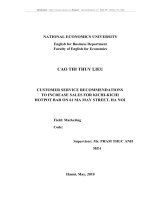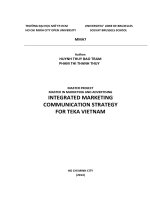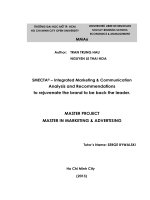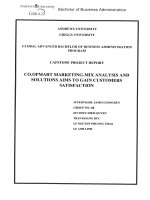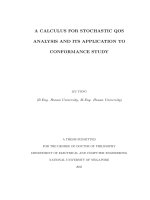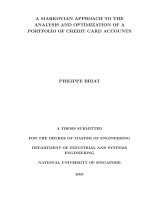forxiga integrated marketing communication analysis and recommendations to increase brand awareness and brand association
Bạn đang xem bản rút gọn của tài liệu. Xem và tải ngay bản đầy đủ của tài liệu tại đây (1.71 MB, 91 trang )
HO CHI MINH CITY OPEN UNIVERSITY
UNIVERSITÉ LIBRE DE BRUXELLES
SOLVAY BRUSSELS SCHOOL OF
ECONOMICS & MANAGEMENT
MMCoM9
NGUYEN THI THANH PHUONG
TRAN BOI DUNG
FORXIGA- INTEGRATED MARKETING &
COMMUNICATION ANALYSIS AND
RECOMMENDATIONS TO INCREASE
BRAND AWARENESS AND BRAND
ASSOCIATION
MASTER FINAL PROJECT
MASTER IN MARKETING AND COMMUNICATION MANAGEMENT
Ho Chi Minh City
(2016)
i
STATEMENT OF AUTHENTICATION
We, Tran Boi Dung and Nguyen Thi Thanh Phuong commit that we have done this
project by ourselves based on the information collected from the public and
ASTRAZENECA VIETNAM’s sources.
This paper is designed only for the academic purpose of the completion of our Master in
Marketing and Communication. It is not expected for any other uses.
ii
ACKNOWLEDGEMENTS
We would like to express our deep gratitude to Mr. Nguyen Le Thai Hoa for his first
guideline of the structure of this project.
Dr. Van Thi Hong Loan deserves a special note of thanks for her comments, advices and
approval on this paper.
We are indebted to Mr. Nguyen Tien Chau and his staffs in AstraZeneca Vietnam for
their continued encouragements and useful documents.
Finally, we must express our deep appreciation to all of my colleagues, friends, and our
familys, who always give us their support throughout.
iii
ACADEMIC TUTOR AND PRACTICAL TUTOR’S COMMENTS &
APPROVAL SIGNATURE
iv
TABLE OF CONTENT
STATEMENT OF AUTHENTICATION......................................................................................i.
ACKNOWLEDGMENT ..................................................................................................................ii
LIST OF CHART ............................................................................................................................vii
LIST OF TABLE .............................................................................................................................viii
LIST OF FIGURE. ...........................................................................................................................ix
LIST OF ABBREVIATION.............................................................................................................x
GROSSARY .....................................................................................................................................xi
1. CHAPTER 1: INTRODUCTION ............................................................................................. 3
1.1.
Over view about Vietnam pharmaceutical market & Oral Antidiabetic
Medication market……………………………………………………………. 3
1.1.1 Vietnam pharmaceutical growth and size ................................................ 3
1.1.2 Vietnam Oral Antidiabetic Medication market growth and share ........... 3
1.1.3 Key player in Vietnam ODA market ....................................................... 4
1.1.4 Diabetes epidemiology............................................................................. 5
1.1.5 The unmet needs in diabetic management ............................................... 5
1.2.
Overview about Astra Zeneca and Forxiga ..................................................... 6
1.2.1 Overview about Astra Zeneca .................................................................. 6
1.2.2 Overview about Forxiga .......................................................................... 9
1.2.2.1
Product ................................................................................... 9
1.2.2.2
Price .......................................................................................12
1.2.2.3
Place .......................................................................................12
1.2.2.4
Promotion...............................................................................13
1.3
Problem statement .............................................................................................15
1.4
Project Objective ................................................................................................16
1.5
Methodology .......................................................................................................16
1.5.1 Secondary research……………………………………………………...16
1.5.2 Primary research………………………………………………………...17
CHAPTER 2: LITERATURE REVIEW ......................................................................................19
2.1
2.2
Brand and Brand Equity .........................................................................................19
2.1.1 Definition of Brand ........................................................................................19
2.1.2 Brand Equity ..................................................................................................19
2.1.2.1
Definition of brand equity ......................................................19
2.1.2.2
Conceptualizations of Consumer based brand equity ............20
Brand awareness ......................................................................................................20
2.2.1 Definition of brand awareness .......................................................................20
v
2.3
2.4
4
2.2.2 Measuring brand awareness ...........................................................................21
Brand association .....................................................................................................22
2.3.1 Definition of brand association ......................................................................22
2.3.2 Aaker’s categorization of brand association ..................................................22
2.3.3 Brand association’s role in creating equity ....................................................23
2.3.4 Measuring brand association..........................................................................25
Integrated Marketing communication ...................................................................25
2.4.1 Definition of integrated marketing communication .......................................25
2.4.2 The marketing Communication mix ..............................................................27
2.4.3 The marketing communication process .........................................................27
2.4.3.1
The communication process Kotler .......................................28
2.4.3.2
Steps in developing effective marketing communication ......29
2
3 CHAPTER 3: RESEARCH RESULTS AND CRITICAL ANALYSIS ............................ 30
3.1
Problem identification ....................................................................................... 30
3.1.1 FORXIGA sale performance analysis ..................................................... 30
3.1.2 FORXIGA sale analysis conclusion ........................................................ 34
3.2
Problem analysis ................................................................................................ 35
3.2.1 FORXIGA brand awareness analysis ...................................................... 35
3.2.2 FORXIGA brand association analysis ..................................................... 37
3.2.3 FORXIGA communication process analysis ........................................... 38
3.2.4 FORXIGA marketing and communication analysis ................................ 40
3.3
Conclusion from market research result analysis and analyses FORXIGA
Marketing Communication ........................................................................................ 42
3.4
Macro analysis .................................................................................................... 43
3.5
FORXIGA’s competitors analysis .................................................................... 44
3.6
The unique selling point of FORXIGA ............................................................ 45
3.6.1 Compare to other medication in SGLT2i classes .................................... 45
3.6.2 Compare to medication in different class ................................................ 45
3.7
FORXIGA SWOT analysis ............................................................................... 45
3.7.1 Strengths .................................................................................................. 46
3.7.2 Weaknesses .............................................................................................. 46
3.7.3 Opportunities............................................................................................ 46
3.7.4 Threats...................................................................................................... 47
CHAPTER 4: CONCLUSIONS AND RECOMMENDATIONS .......................................... 48
4.1
Conclusion .......................................................................................................... 48
4.2
Recommendations for FORXIGA .................................................................... 49
4.3
Integrated Marketing communication plan for FORXIGA in 2016. ............ 50
4.3.1 FORXIGA Target audience. .................................................................... 50
4.3.2 FORXIGA Marketing Communication Objective. .................................. 51
vi
4.3.3
4.3.4
4.3.5
4.3.6
4.3.7
FORXIGA Communication messages. .................................................... 51
FORXIGA Marketing communication mix. ............................................ 52
4.3.4.1 Personal selling. ........................................................................... 52
4.3.4.2 Seminar, Scientific meeting ......................................................... 52
4.3.4.3 Advertising ................................................................................... 55
4.3.4.4 Worth of month Marketing. ......................................................... 56
4.3.4.5 Public relationship. ...................................................................... 57
Budget allocate......................................................................................... 58
Timeline ................................................................................................... 59
Measurement and feedback...................................................................... 59
REFERENCE ............................................................................................................................. 60
APPENDIX 1 .............................................................................................................................. 61
APPENDIX 2. ............................................................................................................................. 69
APPENDIX 3. ............................................................................................................................. 70
APPENDIX 4. ............................................................................................................................. 71
APPENDIX 5. ............................................................................................................................. 74
vii
LIST OF CHART
Chart 1.1: Market value of Brand-name drug vs Generic drug in antidiabetic market.......................4
Chart 1.2: Leading corporations in Vietnam pharmaceutical market .................................................7
Chart 1.3: Leading corporations in Vietnam pharmaceutical market – Ethical sector .......................7
Chart 1.4: FORXIGA sale performance 5 months after launching .................................................15
Chart 3.1: The sale performance of FORXIGA 5 month after launching Compare with Januvia ...30
Chart 3.2: FORXIGA channel sale overview ...................................................................................32
Chart 3.4: FORXIGA Private hospital sale over view 5 month after ...............................................33
Chart 3.5: FORXIGA Government hospital sale over view 5 months .............................................34
Chart 3.6: The brand awareness of FORXIGA and other DPP4i brands .........................................35
Chart 3.7: The familiar of Doctor to type 2 diabetes drugs ..............................................................36
Chart 3.8: The important of treatment objectives in type 2 diabetes management ..........................37
Chart 3.9: The perceptions of Doctor toward FORXIGA advantage and disadvantage ...................38
Chart 3.10: The key messages that FOXIGA MR use to delivery to doctors...................................39
Chart 4.1: FORXIGA marketing communication budget allocate ...................................................58
Chart 6.1: Market value and market share of Vietnam OAD market 2011-2015 .............................74
Chart 6.2: Vietnam OAD market overview in value ........................................................................75
Chart 6.3: Vietnam OAD market overview in unit ...........................................................................75
viii
LIST OF TABLE
Table 1.1: Total Market sales (2014 – 2019) ......................................................................................3
Table 3.1: Summary of FORXIGA marketing activities since 2014 – 2015 ....................................40
Table 4.1: Key messages for FORXIGA based on target patients ....................................................52
ix
LIST OF FIGURE
Figure 1.1: Product image .................................................................................................................10
Figure 1.2: Forxiga key visual image and logo .................................................................................13
Figure 2.1 Types of Brand Association (Aaker 1991) ......................................................................23
Figure 2.2: Brand Associations as value creators for a company (Aaker 1991) ...............................24
Figure 2.3: 4C’s versus 4P’s of marketing (source: Integrated Marketing Communication by Schultz,
Tannenbaum, and Lauterborn) ...........................................................................................................26
Figure 2.4: The communication process (source: Kotler 2003, P.565) .............................................29
Figure 4.1: FORXIGA marketing communication timeline .............................................................59
Figure 6.1: Anti hyperglycemic therapy in type 2 diabetes: General recommendation ....................70
x
LIST OF ABBREVIATIONS
OAD:
Oral anti-diabetes
SGLT2i:
Sodium glucose co-transporter inhibitor
DPP4i
Dipeptidyl peptidase 4 inhibitor
SOC
Standard of care
IDF
International Diabetes Foundation
SU
Sulfonyl Urea
MR
Medical Representative
xi
GLOSSARY
Type II diabetes: Diabetes is a problem with your body that causes blood glucose (sugar)
levels to rise higher than normal. This is also called hyperglycemia. Type 2 diabetes is the most
common form of diabetes.
If you have type 2 diabetes your body does not use insulin properly. This is called insulin
resistance. At first, your pancreas makes extra insulin to make up for it. But, over time it isn't
able to keep up and can't make enough insulin to keep your blood glucose at normal levels.
Hyperglycemia: Hyperglycemia is the technical term for high blood glucose (blood sugar).
High blood glucose happens when the body has too little insulin or when the body cannot
use insulin properly.
Hypoglycemia: Low blood sugar (glucose). Hypoglycemia may be associated with
symptoms such as anxiety, sweating, tremor, palpitations, nausea, and pallor.
Hypoglycemia also starves the brain of glucose energy, which is essential for proper
brain function. Lack of glucose energy to the brain can cause symptoms ranging
from headache, mild confusion, abnormal behavior, loss of consciousness, seizure, and
coma. Severe hypoglycemia can cause death.
Insulin therapy: Medications, which contain insulin. The two main categories of insulin
are human insulin and modern insulin. Human insulin is made by recombinant
biotechnology and is molecularly identical to endogenous human insulin. Regular human
insulin is a rapid acting insulin, whereas intermediate acting or premixed human insulins
have an extended pharmacokinetic profile due to formulation enhancements.
Non insulin therapy: Medications, which do not contain insulin. Non-insulin
antidiabetic drugs are mostly oral therapies and are typically prescribed as first line
therapy when diet and exercise alone are insufficient to control elevated blood glucose.
Noninsulin therapeutics can be sub segmented into standard of care (SOC) therapies and
add onto SOC.
Brand name product: A drug that has a trade name and is protected by a patent (can be
produced and sold only by the company holding the patent).
xii
Generic product: Generic drugs are copies of brand-name drugs (when the patent
protection for a brand-name drug expires) that have exactly the same dosage, intended
use, effects, side effects, route of administration, risks, safety, and strength as the original
drug. In other words, their pharmacological effects are the same as those of their brandname counterparts.
Oral antidiabetic medication: is the group of antidiabetic medications, which are
administered orally.
Rx: A medical prescription. The symbol "Rx" is usually said to stand for the Latin word
"recipe" meaning "to take."
1
ABSTRACTS
Diabetes is one of the largest global health emergencies of the 21st century. Each year
more and more people live with this condition, which can result in life-changing
complications. In 2015, addition to the 415 million adults who are estimated to currently
have diabetes, there are 318 million adults with impaired glucose tolerance, which puts
them at high risk of developing the disease in the future. According to IDF report in
2015, the number of patient will have to suffer from diabetes will be 642 million in 2040
which mean 1 in 10 adults will have diabetes.
Diabetes problem is out of control. Half of diabetes patients cannot achieve the treatment
target. Current medication have many side effects such as: hypoglycemia, weight gain,
increasing cardiovascular risk…There is always a need for a new antidiabetic medication
to support doctors in the fight against diabetes.
FORXIGA is the first oral antidiabetic of SGLT2i (Sodium Glucose co-transporter
inhibiter) group which is launched in Vietnam in August 2015. SGLT2i has novel
insulin-independence mechanism of action. FORXIGA was considered one in ten
medical revolutions in 2012. FORXIGA profile is outstanding to other competitors in
the current market. Therefore, AstraZeneca expects that after launching, FORXIGA
will be the blockbuster in Vietnam Oral Antidiabetic Medication market.
After launching FORXIGA for five months and running marketing activities for 1
year: actual sale is under expectation.
The purpose of this project is to identify and analyze reasons lead to low performance
of FORXIGA as well as recommend a new marketing communication plan for
FORXIGA in order to increase brand awareness and brand association.
Some desk researches have been done. We do a lot of secondary analysis on the macro
environment, competitors and internal sale of FORXIGA. Moreover we conduct a
2
small research on the internal FORXIGA Medical representatives (Med Rep) to
reconfirm what we find from the secondary analysis. Through some findings, the full
evaluation of current marketing and communication activities has been made to show
which ones are effective and which ones are not.
As the result, we find out that low brand awareness and weak brand association are
the reasons lead to the poor performance of FORXIGA. The reasons lead to low brand
awareness and weak brand association lay on the communication message and
communication mix of FORXIGA.
The project gives recommendations in order to help FORXIGA take advantage of the
first player in market. Building up a brand awareness and brand association for
FORXIGA: an effective anti-diabetic medication in term of: control glycaemia,
reduce cardiovascular risk factors and safety which a novel mechanism.
3
1. CHAPTER 1: INTRODUCTION
1.1.
Overview about Vietnam pharmaceutical
market & Oral Antidiabetic
Medication market
1.1.1. Vietnam pharmaceutical market growth and size:
In Southeast Asia, Vietnam is one of the fastest growing pharmaceutical Market.
The Vietnamese pharmaceutical market is forecast to grow at a compound annual
growth rate (CAGR) of 6.9% (±1.5%) between 2014 and 2019, reaching 3725
million USD by 2019.
Table 1.1:
1.1.2. Vietnam Oral Antidiabetic Medication market growth and share
Vietnam Oral Antidiabetic Medication market is the dynamic market.
Antidiabetic-market is one of the fastest growing market in Vietnam
pharmaceutical market. Base on the IMS report in quarter 4-2015, the total
market value in 2015 is 88.13 million USD with the good growth rate 15% in
compare to the growth of total Vietnam pharmaceutical market 6.8%.
Even though in Vietnam Pharmaceutical market, generic drugs overwhelm
branded drugs, in antidiabetic sector, brand drugs have bigger share comparing
with generic drugs. (See chart 1.1)
4
Chart 1.1: Market value of Brand-name drug vs Generic drug in antidiabetic
market
100
88.13
90
Market value (Mil USD)
80
76.67
70
60
39.91
35.79
50
40
30
20
40.88
48.22
10
0
FY 2014
FY 2015
Generic drug
35.79
39.91
Brand-name Drug
40.88
48.22
Source: IMS report December 2015
In brief, pharmaceutical market in Vietnam is the dynamic market.
Especially the OAD (oral antidiabetic medication) market is more dynamic
with two-digit growth rate 15% comparing with total pharmaceutical market
(growth rate 6.8%). Even though generic drugs dominate the Vietnam
pharmaceutical market, in OAD market, brand name medications are still be
preferred than generic medications.
1.1.3. Key player in Vietnam OAD market
There are 372 antidiabetic medications in Vietnam market with both brandname medications and generic medications. In general, they belong to two
groups: Insulin therapy and Non-insulin therapy.
In this project, we just focus on the Non-insulin therapy and mostly it is the Oral
Antidiabetic Medication market.
5
Even though doctors have many medications to help patients to fight against
Diabetes but they are not enough. There are still around 50% of diabetes patients
cannot reach the treatment target.
1.1.4. Diabetes epidemiology
Diabetes is the “plague” in Vietnam with rapid development
Diabetes in Vietnam have tended to increase over time and according level of
economic development and urbanization.
The results announced by the "National Diabetes Prevention Project" of the
National Endocrinology Hospital performed in 2012 on 11,000 people aged 3069 showed that the incidence of diabetes was 5.7% (the highest incidence is in
the South West 7.2%, the lowest was 3.8% Central Highlands). The rate of
glucose intolerance increased strongly from 7.7% in 2002 to nearly 12.8% in
2012.
In conclusion, the incidence of diabetes in Vietnam has double within only 10
years. This figure is alarmed because in the world, it took 15 years to double the
number of diabetes patients. Meanwhile, 75.5% Vietnamese, who are asked,
have very low knowledge about diabetes and that make the Vietnam’s diabetes
picture get worse.
In brief, there are many antidiabetic medications for doctors to
prescribe but the picture about diabetes in Vietnam is miserable. The
incidence of diabetes has double only in 10 years. In 2011, 5.7% of Vietnam
population suffer from diabetes and this number has increased day by day.
The worse is only 50% of diabetes patients can meet the treatment target.
1.1.5. The unmet needs in diabetic management
There are three unmet needs in diabetic management:
1. Half of diabetes patients cannot control blood glucose with current treatments.
6
2. Overweight is a risk factor which leads to diabetes but most of antidiabetic
medications’ side effect is gaining weight (especially insulin, SU…)
3. Most of current antidiabetic medications have insulin dependence mechanism
such as: stimulate the beta cell in pancreas to secrete more insulin or increase
insulin sensitive in muscle… while beta cell function in diabetes patients will
get worse by time.
In brief, with these unmet needs, there is a need for a new medication
with insulin independence mechanism of action to help patients
control blood glucose and other risks factors.
1.2.
Overview about AstraZeneca and FORXIGA
1.2.1. Overview about AstraZeneca
AstraZeneca is the British Swedish multinational pharmaceutical and biology
company. The headquarter is in London, UK.
In the world, AstraZeneca is the eighth largest pharmaceutical company. In
Vietnam, AstraZeneca come at the third place but in ethical sector AstraZeneca
in the leader in Vietnam Market. (See chart 1.2 and chart 1.3)
7
Chart 1.2: Leading corporations in Vietnam pharmaceutical market
Source: IMS health report
Chart 1.3: Leading corporations in Vietnam pharmaceutical market – Ethical sector
Source: IMS health report Q2-2015
8
AstraZeneca Representative Office in Vietnam was established since 1995.The
main mission of the Representative office is commercial operation in both sales
and marketing activities. Now, AstraZeneca Representative Office in Vietnam
has covered in 34 cities and provinces with total 420 employees. There are 18
brands in ethical sector. The turnover of AstraZeneca Vietnam in 2015 was 76.8
millions USD. In Ethical Market (prescription medication market), AstraZeneca
is the forth largest company with the good growth rate (22%) above the market
average (19%). (Source: PGI Scorecard Dec’2015)
AstraZeneca has a portfolio of product for major disease areas including: cancer,
cardiovascular and metabolism, gastrointestinal, infection, neuroscience and
respiratory.
Product portfolio:
-
Cardiovascular and metabolism disease: Crestor, Zestril, Plendil, Betaloc ZOK,
Brilinta
-
Diabetes and metabolism: Onglyza, Komboglyze XR, FORXIGA.
-
Respiratory: Pulmicort, Symbicort.
-
Gastrointestinal: Nexium.
-
Infection: Meronem.
-
Neuroscience: Seroquel XR, Anaropine, Marcaine.
-
Oncology: Irressa, Faxodex, Zoladex.
Diabetes and metabolism medication in the new portfolio in AstraZeneca in
compare with others brand. Onglyza, Komboglyze XR and especially FORXIGA
are put in the growth platform of company which will be received high investment
than other mature brands.
In brief, FORXIGA is the product of AstraZeneca, which is one out of ten
biggest pharmaceutical company in the world as well as in Vietnam. The
product portfolio of AstraZeneca covers many treatment areas. Diabetes in
9
general and FORXIGA in specific are in the growth platform, which means
the budget for marketing is much higher than other mature brands.
1.2.2. Overview about FORXIGA
We evaluate the product FORXIGA with 4Ps (Product, Price, Promotion and
Place) to have a general view about FORXIGA in Vietnam.
1.2.2.1. PRODUCT
FORXIGA is the brand name of DAPAGLIFLOZIN. DAPAGLIFLOZIN is the
first in a new class of oral selective sodium-glucose co-transporter 2 (SGLT2)
inhibitors designed for treating type 2 diabetes.
a. Mode of action:
DAPAGLIFLOZIN improves hyperglycemia by inhibiting renal glucose
reabsorption through SGLT2. SGLT2 is a sodium-solute cotransport protein
located in the kidney proximal tubule that reabsorbs the majority of glomerularfiltered glucose. As the result, glucose cannot be absorbed back to circulation
system and will excrete through urine. Therefore, DAPAGLIFLOZIN helps lower
the glucose level in blood. In short, DAPAGLIFLOZIN represents a paradigm
shift in diabetes treatment because it reduces blood sugar in new way – by causing
it to be excreted during urination. The mechanism of DAPAGLIFLOZIN is
insulin independence.
FORXIGA is approved to use in Europe and Australia in 2012. Until January,
2014 FDA finally approved for FORXIGA to be used in the American market.
Now FORXIGA is available in 66 countries around the world.
Pattern expired day of DAPAGLIFLOZIN is 4 October 2020.
Figure 1.1: Product image
10
b. Therapeutic indications
FORXIGA is indicated in adults aged 18 years and older with type 2 diabetes
mellitus to improve glycemic control as:
o Monotherapy
When diet and exercise alone do not provide adequate glycemic control in patients
for whom using of metformin is considered inappropriate due to intolerance.
o Add-on combination therapy
In combination with other glucose lowering medicinal products including insulin,
when these, together with diet and exercise, do not provide adequate glycemic
control.
c. Method of administration
FORXIGA can be taken orally once daily at any time of day with or without food.
Tablets are to be swallowed whole.
d. The advantage of FORXIGA in comparison with other oral antidiabetic
medications:
-
Novel mode of action, which is insulin independence, therefore FORXIGA can
use for diabetes patients regardless of beta cell function. Moreover, with the new
mechanism FORXIGA is the perfect combination with other antidiabetic
medications, which have insulin dependence mode of action.
11
-
Control HbA1c effectively.(HbA1c is an index using to monitor blood glucose.
Normal people have HbA1c <7%, in diabetes patient HbA1c>7%. Therefore,
diabetes patient need to use medication to reduce HbA1c lower than 7%). When
comparing to other OAD medications the effect of FORXIGA in HbA1c
reduction is just lower than SU (Sulfonyl Urea) and Metformin but higher than
DPP4i. But the glycaemia effect of FORXIGA is more sustainable than other
medications (4 years clinical trial) (See table 1.1)
Table1.1: HbA1c reduction comparison among Oral Antidiabetic medications
Oral antidiabetic medication
HbA1c reduction (%)
Metformin
1-1.5
Sulfonyl urea (SU)
1-1.5
DPP4i
0.5-1
FORXIGA (DAPAGLIFLOZIN)
0.7-1
Alpha Glucosidase Inhibitor
0.5-1
-
Low risk of hypoglycemia: 10 time lower than SU.
-
Additional benefits: Weight loss (average 3-4 kg) and lower systolic blood
pressure (average 4-5 mmHg). FORXIGA is the first OAD medication have these
benefits.
In brief, FORXIGA is a good antidiabetic medication with insulin
independence mechanism of action. Beside the good effect on reducing
HbA1c, Forxiga also has low risk of hypoglycemia (which is the dangerous
side effect of many OADs). Moreover, FORXIGA has the additional
benefits that are losing weight and reducing blood pressure.
1.2.2.2. PRICE:
Forxiga has two doses Forxiga 5mg and Forxiga 10 mg, which have the same
price: 22.800 VND/tablet, 6384.000 VND/box.
12
AstraZenca Vietnam sets up the premium price for FORXIGA in the OAD
market, which is 20 % higher than the average price of DPP4i (19,000 VND) and
much higher than SU and Metformin.
1.2.2.3. PLACE:
Firstly, FORXIGA focuses on two biggest cities of Vietnam, which are Hanoi and
Ho Chi Minh City because 90% big hospitals place in these cities.
Due to the listing process to give a new medication into hospital is complex and
depends on each hospital, each city. Five months after launching, FORXIGA is
available in 18/25 biggest hospitals and 85 pharmacies in Hanoi and HCMC focus
on the big pharmacies and pharmacies around the hospitals.
1.2.2.4. PROMOTION
a. Target doctors:
FORXIGA targets to three types of doctors who will prescribe anti diabetic
medication.
Endocrinology doctors
Cardiovascular doctors
General practice doctors
b. Target patients:
Due to the information in FORXIGA prescription information. FORXIGA is
suitable for type II diabetic patients who have sufficient renal function (eGFR ≥
60ml/min/1.73m2.)
Because FORXIGA has just launched therefore it is suitable for non-insurance
patients and self-paid patients.
FORXIGA targets to type 2 diabetes patients with have sufficient renal
function and self-paid patients who already fail in blood glucose control
with Metformin.

